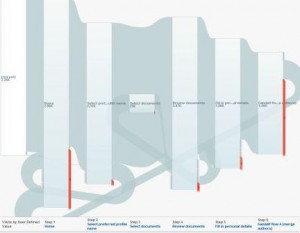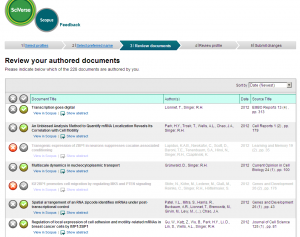Published 2012/06/05
Free version available here: http://scopusfeedback.com/
Scopus Author Profiles are created by algorithm. While the algorithm has high recall and precision, no algorithm is perfect. When an author discovers an error in their profile, it is important that they can get it fixed quickly and efficiently. In the past, a simple form was provided that enabled an author to describe what was wrong. This was then processed by a dedicated support team, which often resulted in multiple communications between authors and support staff. The process support staff followed to submit the change to the system was also predominantly manual.
A solution to improve this situation needed to be put in place as soon as possible. Because of the urgency we chose to pursue this project outside of our normal development cycle and instead hired a local developer (who also develops our prototypes) to work on the solution. Working in a small team that consisted of a UX Specialist, an Author Feedback Support Manager, a developer, and myself we created the Scopus Feedback Wizard.
This process was highly agile, which enabled us to constantly test with users and iterate accordingly. In collaboration with Product Marketing we began a live pilot (03/2011) as soon as the core was in place. Sales invited over 40 customers to participate, including those who were most urgently in need of the tool. Additionally +1390 individuals were invited, including Elsevier Editors and the Innovation Explorers community. During the pilot, 973 feedback requests were submitted and 220 surveys completed.

The full launch of the Wizard included integration into context in Scopus.com. The relevant metadata and user information is passed between Scopus and the Wizard (This same mechanism is now being used to integrate Scopus Feedback with ORCID). Depending on context, a user begins one of four different task specific workflows. Through Google Analytics, we are able to track completion rates for each stage of each workflow to identify potential sticking points.
Equally important to the end-user facing component, the Wizard automates many processes for the support team. Previously manual data collection and processing has been automated. This minimizes the number of necessary customer communications and enables the support staff to focus on the most difficult cases. To do this, we modeled an algorithm on the decision process of the Author Feedback Support team member (resulting in the James Algorithm).
Since launch, requests have nearly doubled, but processing times have approximately halved.
Try it here: http://scopusfeedback.com/ or return to Portfolio

I have tried the wizard yesterday, helping a reseacher of the University of Trieste, Italy.
I work as librarian and do also information retrieval for academic staff.
I have a question: if a reseachers has some articles which are not retrievable in Scopus, how does he add these citations?
There is a big problem in Italy, overall with Italian publications, which are not indexed in Scopus database.
Thank you for an answer.
Kind regards,
Marco Chiandoni